Which machine to put on the washing machine?
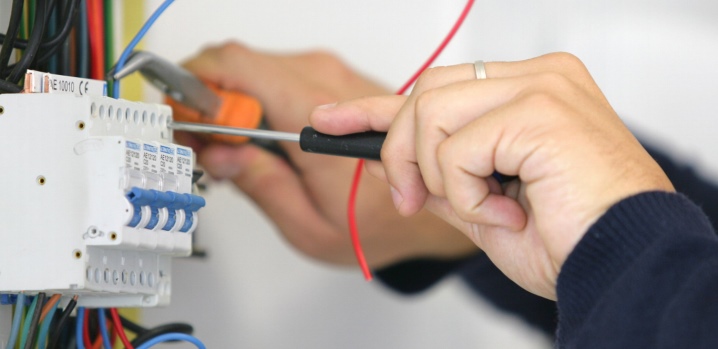
The article discusses which short-circuit protection circuit breaker needs to be installed on the washing machine, how many amperes to choose the disconnecting device, what rating of the machine's characteristics is needed. We will give advice on the selection and installation of electrical protection devices.
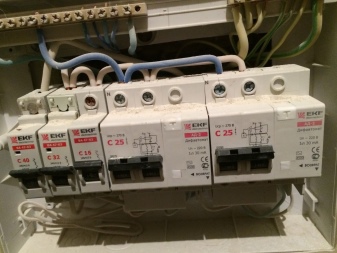
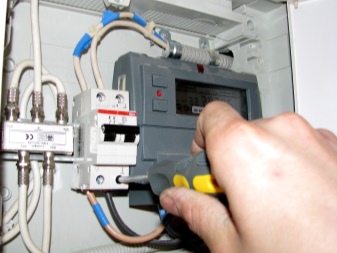
What is a washing machine machine?
A circuit breaker is a device that prevents equipment breakdown in the event of a short circuit and overload of the electrical network. The device consists of several main parts:
- casing made of insulating material;
- transformer;
- chain breaking mechanism, consisting of movable and fixed contacts;
- self-diagnosis system;
- pads for connecting wires;
- DIN rail mounting.
When the voltage or current exceeds the permissible value, the electrical circuit will open.

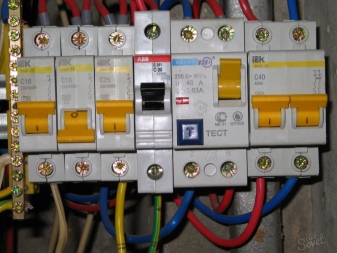
Why is it needed?
A modern washing machine consumes a lot of electricity in the water heating and spinning mode. A large current flows through the network, which heats up the wires. As a result, they can catch fire, especially when the wiring is aluminum. If this does not happen, the insulation may melt, and then a short circuit will occur. Protection sensors make sure that the current does not exceed the limit values, there is no fire.
Typically, the machine is installed in a bathroom where the air humidity is high. Excess moisture negatively affects the resistance of insulators, they begin to pass current. Even if it does not come to a short circuit, a voltage hazardous to human life will fall on the body of the device.
Touching such a device will result in an electric shock, the consequences of which are unpredictable and depend on the electrical potential on the case. Damage will intensify if you touch the machine and a conductive object, such as a bathtub, at the same time.

Residual current devices make sure that no voltage from the mains gets on the machine body, and when it appears, they immediately turn off the equipment. Washing machines are best connected to separate machines. The fact is that they are very powerful current consumers and create a heavy load on the power grid. Then, in the event of a short circuit, only the machine will turn off, and all other devices continue to work on.
When a powerful consumer is turned on, voltage surges may occur. They negatively affect all devices connected to the network. That's why in addition to protection devices, it is recommended to use a voltage stabilizer. So the electrical safety system is very relevant. And there are a number of devices to provide it.
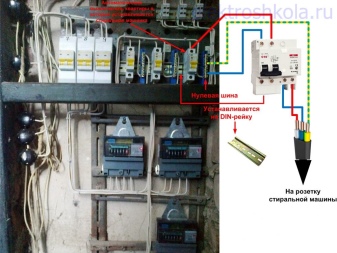
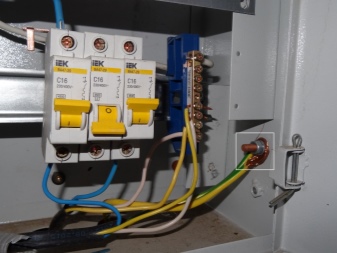
Views
There are several types of devices for protection against electric shock. They differ in their principle of operation, but are similar in connection scheme.
Residual current circuit breaker or AO
It is a sensor that reacts to power consumption. When current passes, the wire heats up, when the temperature rises, the sensitive element (usually a bimetallic plate) opens the circuit. The sensor is needed to instantly turn off the device in the event of a short circuit. If the load slightly exceeds the permissible, the delay can be up to 1 hour.
Previously, the "automatic" was a conventional fuse that had to be changed after each operation. Today's devices are reusable and can last for years.
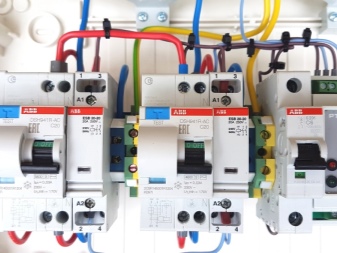
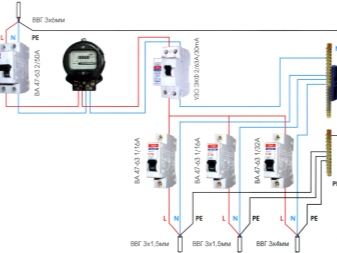
RCD
An RCD (Residual Current Device) monitors the currents in the two wires of the power line. It compares the currents in the phase and in the neutral wire, which must be equal to each other. The difference between them is called the leakage current, and if it is greater than a certain value, the consumer is turned off. Leakage can be caused by various reasons, such as moisture in the insulation. As a result, the body of the washing machine may be energized. The main task of an RCD is to prevent the leakage current from exceeding a certain value.
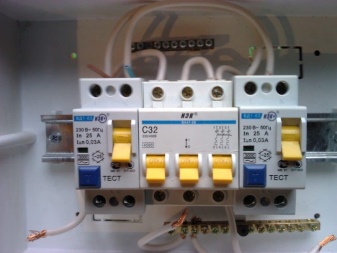
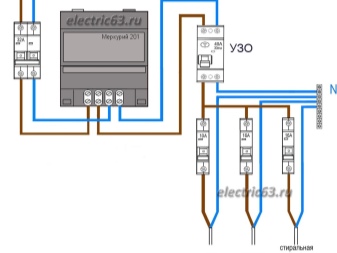
Difautomat
Differential automatic device is a device that combines a residual current circuit breaker and an RCD in one housing. The advantages of this solution are ease of connection and space saving on the DIN rail. Disadvantage - if triggered, it is impossible to determine the cause of the malfunction. Moreover, the price of such a device is high. In practice, a scheme with separate AO and RCDs is usually used. This allows in the event of a malfunction, change only one device.
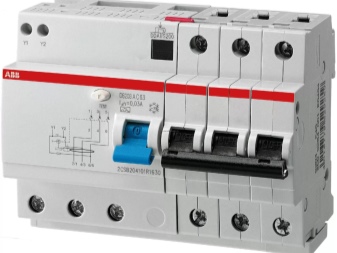
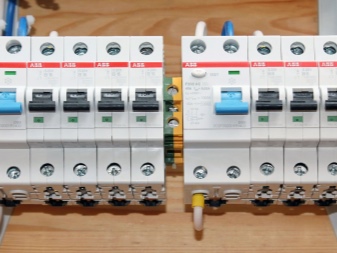
How to choose?
Before choosing, it is necessary to calculate the maximum current that the protection must pass. This is quite simple to do. As you know, the current power is determined by the formula P = I * U, where the power P is measured in W; I - current strength, A; U - mains voltage, U = 220 V.
The power of the washing machine P can be found in the passport or on the back wall. Usually it is equal to 2-3.5 kW (2000-3500 W). Next, we derive the formula I = P / U and after calculating we obtain the required value. It is 9-15.9 A. We round the resulting value to the nearest higher number, that is, the limiting current strength is 16 Amperes (for powerful machines). Now we select the residual current circuit breaker according to the found amperage.
A slightly different situation is with the choice of RCDs. As already mentioned, with a slight excess of power, the AO does not work for a long time, and the RCD has an additional load. This will shorten the life of the device. So the current rating of the RCD must be one step higher than that of the AO. More on this in the next video.
Here are some general tips for choosing protection devices.
- For stable operation of all devices, it is recommended to use voltage stabilizers.
- The optimum leakage current of the RCD should be 30 mA. If more, then the protection will be unsatisfactory. If less, there will be false alarms caused by the high sensitivity of the sensor.
- For domestic use, it is recommended to use machines with the C marking. For the outlet network, it is advisable to take the C16 machine.
- The optimal RCD class is A. Devices of the AC group may not always work correctly.
- It's better not to skimp on defense. Buy only quality appliances from reputable manufacturers. Remember that the cost of the most expensive difavtomat will be much lower than the price of a new washing machine.
Now the selected device needs to be connected.
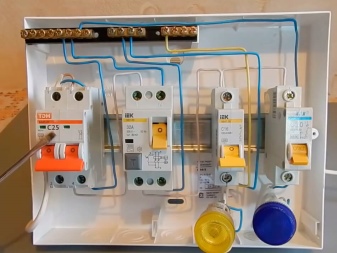
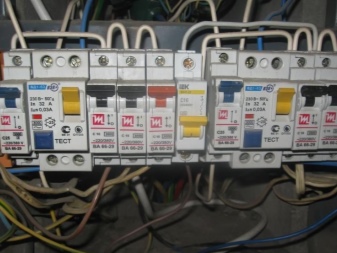
How to install and connect?
Installation of protection devices is not difficult, even for non-specialists. You just need to follow the scheme. Of the tools, you only need a wire stripper and a screwdriver. It is better to install appliances outside the bathroom. Make sure toggle switches are easily accessible. Installation is carried out in the following sequence.
- Find the phase and zero on the input wire.
- Connect a voltage stabilizer if necessary.
- The wiring phase is initiated at the AO input.
- The AO output is commutated with the phase input to the RCD.
- The working zero is connected to the zero input of the RCD.
- Both RCD outputs are connected to a power outlet.
- The ground wire is connected to the corresponding terminal on the socket.
- The devices are mounted on a DIN rail with latches.
- Check that all contacts are tight. This is especially true for extension cords.
For installation, use the diagram below.
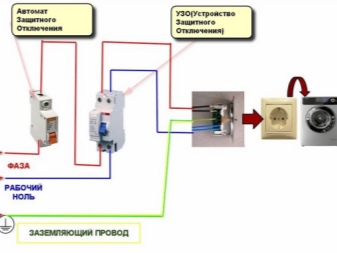
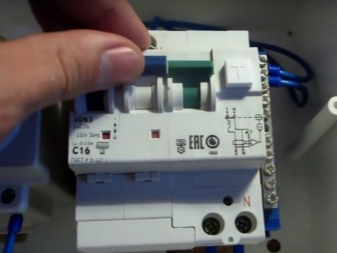
Never place switches in the ground wire. It is not recommended to use zeroing instead of grounding (this is when the "ground" pin is connected to a working zero).The circuit works well in normal operation. But with a short circuit, the current flows through the neutral wire. Then, instead of removing the potential, the zeroing directs it to the body.
If there is no standard grounding, lay a wire for it anyway. When upgrading the electrical system, it will come in handy. The DIN rail must also be connected to it.
But sometimes it happens that with the correct connection, the machine does not work, since the power system is de-energized.
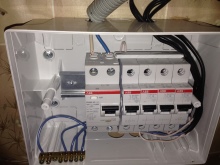
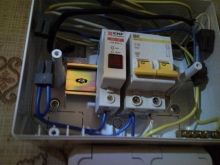
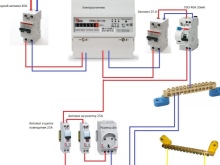
Why does the machine turn off
Protection devices can be triggered for no apparent reason when turned on. There may be several reasons.
- Voltage surges when a powerful consumer is turned on. Use a stabilizer to eliminate them.
- Incorrect device connection. The most common mistake is that the phase and zero are mixed up. Check all connections.
- Wrong choice of instruments. Check their ratings and your calculations.
- Short circuit in the cable. Make sure the insulation of the wires is in order. The multimeter should show infinite resistance between two open wires.
- Defective protection devices.
- The washing machine itself has deteriorated.
If the problem is not found, it is better to seek the help of a specialist. Remember, it's better to overpay for safety than buying a new washing machine.


See below for connecting the washing machine to an RCD.













The comment was sent successfully.